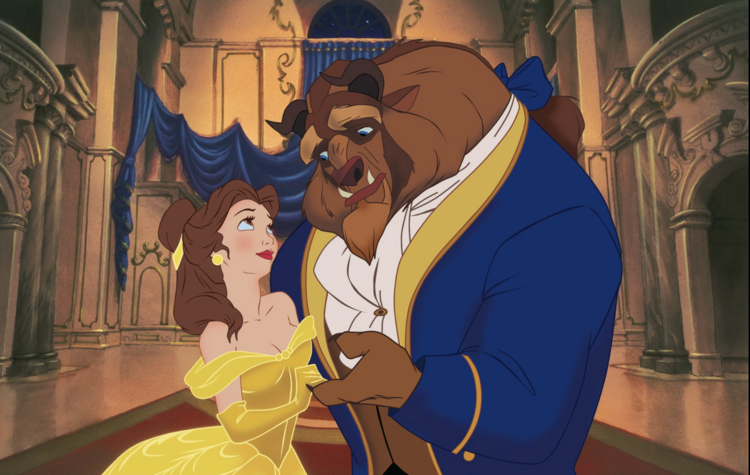August is Musical Month in Catholic Movie Club! We’re going to look at movie musicals from across the history of the genre to see how these song-and-dance spectaculars can teach us about our faith.
The “Disney Renaissance” is one of the most important moments in the recent history of the movie musical. For a decade (from 1989’s “The Little Mermaid” to 1999’s “Tarzan”), the studio’s films experienced a rebirth marked by bold animation, more sophisticated storytelling and–especially—powerful music. The Broadway duo Howard Ashman and Alan Menken created the template, applying their knowledge of how music should propel character and narrative. One example is Ashman’s much-quoted concept of the “I Want” song, a musical number where the protagonist sings about their deepest desire, which has become a staple of the genre. While the Disney Renaissance movies were mostly adaptations of older fairytales, their success was in making those stories resonate for modern audiences.
The pinnacle, in my opinion, is this week’s Catholic Movie Club selection: “Beauty and the Beast” (1991), directed by Gary Trousdale and Kirk Wise, written by Linda Woolverton, with songs by Ashman and Menken. Adapted from the 18th-century French fairytale (and taking inspiration from Jean Cocteau’s 1946 gothic classic of the same name), “Beauty and the Beast” was a massive hit. It became the first animated film in history to receive a Best Picture nomination at the Academy Awards.
The story follows Belle (Paige O’Hara, one of several Broadway luminaries in the cast), an intelligent young woman who doesn’t fit in in her “poor, provincial” village. When her absent-minded father disappears in the woods, she finds him imprisoned in an enchanted castle ruled by a monstrous Beast (Robby Benson). Belle volunteers to take her father’s place, although it means remaining a prisoner forever. She learns that the Beast was once a callow prince, cursed by a sorceress for coldly rejecting her plea for hospitality. Alongside his own horrific transformation, his household staff—including Lumière (Jerry Orbach), Cogsworth (David Ogden Stiers) and Mrs. Potts (Angela Lansbury)—became objects like candelabras and teapots. If the Beast cannot learn to love another and be loved in return before the last petal falls from an enchanted rose, then the curse will be permanent.
“Beauty and the Beast” is, rightly, often discussed as a story about how true beauty is found within. The Beast eventually reveals vulnerability and nobility beneath his savage exterior; Belle, whose community only appreciates her external beauty, is intelligent, courageous and compassionate. But enough of the heroes—I want to talk about the villain: Gaston (Richard White), the boorish hunter who intends to marry Belle whether she is interested or not. In Gaston we find a different but no less timeless message: true ugliness is found within, too, often beneath an attractive exterior.
Like most Disney villains, Gaston is vain, selfish and willing to do horrible things to get what he wants. What makes Gaston different is that people love him. He is the hero of Belle’s small town, celebrated nightly at the local tavern and capable of whipping up a rabid mob with only a few words. While the 2017 live-action remake shows Gaston’s flunky Lefou bribing the townspeople for their support, the original (especially the rousing musical number “Gaston”) makes it clear that their admiration is genuine. They are even willing to follow Gaston as he does objectively horrible things, like scheming to institutionalize Belle’s eccentric father in order to force her to marry him.
Gaston is troubling because he is the Disney villain who resonates most with reality: It’s unlikely that we’ll encounter an Ursula or a Jafar, but we all know a Gaston. He is every swaggering bully with a rabid cult of personality: a boss, a coach, a celebrity, a priest, a politician. From the outside, it seems so transparent: This guy is a buffoon or an abuser, how can people support him?
But evil, as our faith and human history teach us, is seductive. We see it in the reasonable-sounding subversions of the serpent in Genesis and in the false prophet of Revelation. We see it in the “strongman” of fascism, the tough leader who promises that he can solve all of your problems if you give him your unquestioning loyalty. That is a tempting fantasy, and you can imagine why people who otherwise consider themselves moral or committed to democracy might embrace it.
Earlier this summer, Pope Francis warned against the rise of anti-democratic movements around the world: “Some people compare them to the Pied Piper of Hamelin. They seduce you, they lead you to deny yourself.” When we allow ourselves to be taken in by appearances, we risk losing touch with our own deepest values, making us susceptible to participating in evil. “Beauty and the Beast” reminds us that we always must look beneath the surface, especially when it come to the people we idolize. What we find there might be more complicated or less attractive, but it will also be the truth.
“Beauty and the Beast” is streaming on Disney+.








